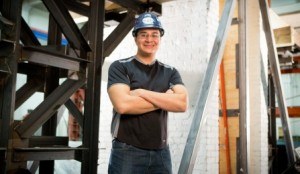Researchers will conduct a rare – if not unprecedented – large-scale earthquake simulation to determine how vulnerable New York’s unreinforced masonry buildings (row houses) are to temblors.
Designed to imitate the 2011 Virginia quake that rattled the East Coast, the test will occur at 11 a.m. Feb. 19 at the University at Buffalo’s Multidisciplinary Center for Earthquake Engineering Research (MCEER).
Two 14-foot-tall walls – built with materials such as 100-year-old brick – will replicate turn-of-the-century row houses (often called “brownstones”) found in New York.
Researchers will use an earthquake shake table within UB’s earthquake simulation lab to mimic the Virginia temblor as if its epicenter was under the New York region. They will use the test results to calculate estimates for property loss and potential human casualties.
Researchers expect the walls to fall apart and crumble to the ground. The test will occur inside a laboratory.
Background
While not common, earthquakes periodically hit the New York City region, including a 5.5 magnitude temblor in 1884, according to the U.S. Geological Survey.
“New York City is not a high seismic zone, but the risk there is significant because of the existing infrastructure and large population,” said Juan Aleman, PhD candidate and Fulbright scholar in UB’s School of Engineering and Applied Sciences. “With this test, we hope to learn how buildings will react to a quake similar to the one that struck Virginia in 2011.”

Aleman is working with Andrew Whittaker, MCEER director and professor and chair of UB’s Department of Civil, Structural and Environmental Engineering; and Gilberto Mosqueda, a former UB researcher, who works as an associate professor in structural engineering at the University of California, San Diego.
The upcoming test is collaboration between UB and the International Masonry Institute.
Source: University of Buffalo
Was this article valuable?
Here are more articles you may enjoy.

 Asahi Sales Drop Worsens as Cyber Hack Disruption Lingers
Asahi Sales Drop Worsens as Cyber Hack Disruption Lingers  Hermès Heir Sues Arnault and LVMH in $16 Billion Suit Over Lost Shares
Hermès Heir Sues Arnault and LVMH in $16 Billion Suit Over Lost Shares  Toyota Unveils Concept LFA Supercar, and It’s Fully Electric
Toyota Unveils Concept LFA Supercar, and It’s Fully Electric  Thailand’s Record Floods Paralyze Key Hubs for Tech and Car Parts
Thailand’s Record Floods Paralyze Key Hubs for Tech and Car Parts 